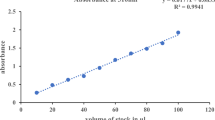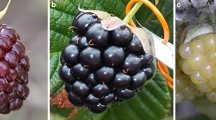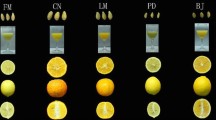Abstract
Cherry fruit is a natural food that has been consumed since ancient times due to its remarkable nutritional and therapeutic properties. In this study, total phenolic, total flavonoid, total monomeric anthocyanin contents, total antioxidant capacity and polyphenolic contents of fruit samples belonging to 14 (two of them endemic) different Prunus (cherry) taxa naturally distributed in Turkey were compared. Qualitative and quantitative determination of 23 individual phenolic compounds (fourteen phenolic acids, five flavonols, one flavan-3-ol, one flavone, one dihydrochalcone and one phytoalexin) was performed by LC–MS/MS (liquid chromatography technique coupled with tandem mass spectrometry). Antioxidant activities of fruit samples were determined using CERAC, CUPRAC and ABTS test methods. According to the results obtained, it was found that Prunus mahaleb var. alpina (107.57 mg cyanidin 3-glucoside/100 g FW) and Prunus mahaleb var. mahaleb (90.95 mg cyanidin 3-glucoside/100 g FW) had higher anthocyanin content compared to other fruit samples. It was determined that Prunus incana var. velutina, one of the endemic species, has a remarkable total phenolic content (10.76 mg gallic acid/g FW), individual phenolic content (641.58 mg/ 100 g, a total of individual phenolics with LC–MS/MS) and total antioxidant capacity (25.1 mg Trolox/100 g FW with CERAC assay). This article is the first study to report the comparative phytochemical content of different Prunus taxa in Turkey and the phytochemical properties of Prunus incana var. velutina. It has been concluded that endemic Prunus incana var. velutina has the potential to be used as an alternative to the taxa Prunus mahaleb, Prunus avium and Prunus vulgaris as a health-protective food and as a food additive due to its remarkable polyphenolic content, anthocyanin content and total antioxidant capacity.



Similar content being viewed by others
Availability of data and materials
The authors declare that the data supporting the findings of this study are available within the article.
References
Kicel A (2020) An overview of the genus Cotoneaster (Rosaceae): Phytochemistry, biological activity, and toxicology. Antioxidants 9:1002
Liu ZY, Xing JF, Chen W, Luan MW, Xie R, Huang J, Xie SQ, Xiao CL (2019) MDR: An integrative DNA N6-methyladenine and N4-methylcytosine modification database for Rosaceae. Hortic Res 6:1–7. https://doi.org/10.1038/s41438-019-0160-4
Potter D, Still SM, Grebenc T, Ballian D, Božič G, Franjiæ J, Kraigher H (2007) Phylogenetic relationships in tribe Spiraeeae (Rosaceae) inferred from nucleotide sequence data. Oesterreichische Bot Z 266:105–118. https://doi.org/10.1007/s00606-007-0544-z
Reynders S, Salesses G (1989) Study of the genetic relationships within the subgenus Prunophora Restriction maps of the ribosomal genes in P. Cerasifera and P. Spinosa. Acta Hortic 283:17–26. https://doi.org/10.17660/actahortic.1990.283.1
Yılmaz KU, Ercişli S, Asma BM, Doğan Y, Kafkas S (2009) Genetic relatedness in Prunus genus revealed by inter-simple sequence repeat markers. HortScience 44:293–297
Cantin CM, Moreno MA, Gogorcena Y (2009) Evaluation of the antioxidant capacity, phenolic compounds, and vitamin C content of different peach and nectarine [Prunus persica (L.) Batsch] breeding progenies. J Agri Food Chem 57(11):4586–4592
García-Gómez B, Salazar JA, Nicolás-Almansa M, Razi M, Rubio M, Ruiz D, Martínez-Gómez P (2021) Molecular bases of fruit quality in Prunus species: an integrated genomic, transcriptomic, and metabolic review with a breeding perspective. Int J Mol Sci 22:333
Hussain SZ, Naseer B, Qadri T, Fatima T, Bhat TA (2021). Cherries (Prunus Cerasus) Morphology Taxonomy Composition and Health Benefits In: Syed Zameer Hussain, Bazila Naseer, Tahiya Qadri, Tabasum Fatima, Tashooq Ahmad Bhat (eds.) Fruits Grown in Highland Regions of the Himalayas, Springer, Cham, pp. 63-75
Al-Tameme HJM (2015) Chemical profiles as chemotaxonomic tools for some species in Fabaceae in Iraq. Al-Qadisiyah J Pure Sci 20:88–99
Bhargava VV, Patel SC, Desai KS (2013) Importance of terpenoids and essential oils in chemotaxonomic approach. Int J Herb Med 1:2321–2187
Umoh OT (2020) Chemotaxonomy: The role of phytochemicals in chemotaxonomic delineation of taxa. taxon,13:14
Wojdyło A, Nowicka P, Laskowski P, Oszmianski J (2014) Evaluation of sour cherry (Prunus cerasus L.) fruits for their polyphenol content, antioxidant properties, and nutritional components. J Agri Food Chem 62(51):12332–12345
Tundis R, Peruzzi L, Menichini F (2014) Phytochemical and biological studies of Stachys species in relation to chemo-taxonomy: a review. Phytochemistry 102:7–39
Ignat I, Volf I, Popa VIA (2011) critical review of methods for characterisation of polyphenolic compounds in fruits and vegetables. Food Chem 126:1821–1835. https://doi.org/10.1016/j.foodchem.2010.12.026
Pacifico S, Di Maro A, Petriccione M, Galasso S, Piccolella S, Di Giuseppe AM, Scortichini M, Monaco P (2014) Chemical composition, nutritional value and antioxidant properties of autochthonous Prunus avium cultivars from Campania Region. Food Res Int 64:188–199. https://doi.org/10.1016/j.foodres.2014.06.020
Rice-Evans CA, Miller NJ, Paganga G (1996) Structure-antioxidant activity relationships of flavonoids and phenolic acids. Free Radic Biol Med 20:933–956. https://doi.org/10.1016/0891-5849(95)02227-9
Viswanath V, Urooj A, Malleshi N (2009) Evaluation of antioxidant and antimicrobial properties of finger millet polyphenols (Eleusine coracana). Food Chem 114:340–346. https://doi.org/10.1016/j.foodchem.2008.09.053
Tagliazucchi D, Verzelloni E, Bertolini D, Conte A (2010) In vitro bio-accessibility and antioxidant activity of grape polyphenols. Food Chem 120:599–606. https://doi.org/10.1016/j.foodchem.2009.10.030
Serradilla MJ, Hernández A, López-Corrales M, Ruiz-Moyano S, de Guía Córdoba M, Martín A (2016) Composition of the Cherry (Prunus avium L. and Prunus Cerasus L, Rosaceae) In: Nutritional Composition of Fruit Cultivars; Academic Press, pp. 127–147
Magalhães LM, Santos F, Segundo MA, Reis S, Lima JL (2010) Rapid microplate high-throughput methodology for assess-ment of Folin-Ciocalteu reducing capacity. Talanta 83:441–447. https://doi.org/10.1016/j.talanta.2010.09.042
Zhishen J, Mengcheng T, Jianming W (1999) The determination of flavonoid contents in mulberry and their scavenging effects on superoxide radicals. Food Chem 64:555–559. https://doi.org/10.1016/s0308-8146(98)00102-2
Giusti MM, Wrolstad RE (2001) Characterization and measurement of anthocyanins by UV-visible spectroscopy. Curr Protoc Food Anal Chem 1:F1–F2. https://doi.org/10.1002/0471142913.faf0102s00
Apak R, Güçlü K, Özyürek M, Karademir SE (2004) Novel total antioxidant capacity index for dietary polyphenols and Vitamins C and E, using their cupric ion reducing capability in the presence of neocuproine: CUPRAC method. J Agric Food Chem 52:7970–7981. https://doi.org/10.1021/jf048741x
Ozyurt D, Demirata B, Apak R (2007) Determination of total antioxidant capacity by a new spectrophotometric method based on Ce(IV) reducing capacity measurement. Talanta 71:1155–1165. https://doi.org/10.1016/j.talanta.2006.06.015
Re R, Pellegrini N, Proteggente A, Pannala A, Yang M, Rice-Evans C (1999) Antioxidant activity applying an improved ABTS radical cation decolorization assay. Free Radic Biol Med 26:1231–1237
Fischer UA, Carle R, Kammerer DR (2011) Identification and quantification of phenolic compounds from pomegranate (Punica granatum L.) peel, mesocarp, aril and differently produced juices by HPLC-DAD–ESI/MSn. Food Chem 127:807–821. https://doi.org/10.1016/j.foodchem.2010.12.156
Bayram NE, Canli D, Gercek YC, Bayram S, Celik S, Guzel F, Morgil H, Oz GC (2020) Macronutrient and micronutrient levels and phenolic compound characteristics of monofloral honey samples. J Food Nutr Res 59:211–322
Bayram NE, Gercek YC, Çelik S, Mayda N, Kostić A, Dramićanin AM, Özkök A (2021) Phenolic and free amino acid profiles of bee bread and bee pollen with the same botanical origin—Similarities and differences. Arab J Chem 14:103004. https://doi.org/10.1016/j.arabjc.2021.103004
Pellegrini N, Serafini M, Colombi B, Del Rio D, Salvatore S, Bianchi M, Brighenti F (2003) Total antioxidant capacity of plant foods, beverages and oils consumed in Italy assessed by three different in vitro assays. J Nutr 133:2812–2819
González-Centeno MR, Jourdes M, Femenia A, Simal S, Rosselló C, Teissedre PL (2012) Proanthocyanidin composition and antioxidant potential of the stem winemaking by products from 10 different grape varieties (Vitis vinifera L.). J Agric Food Chem 60:11850–11858
Viljevac M, Dugalić K, Jurković V, Mihaljević I, Tomaš V, Puškar B, Lepeduš H, Sudar R, Jurković Z (2012) Relation between polyphenolic content and skin colour in sour cherry fruits. J Agric Sci 57(2):57–6
Damar I, Ekşi A (2012) Antioxidant capacity and anthocyanin profile of sour cherry (Prunus cerasus L.) juice. Food Chem 135(4):2910–291
Sivaci A, Duman S (2014) Evaluation of seasonal antioxidant activity and total phenolic compounds in stems and leaves of some almond (Prunus amygdalus L.) varieties. Biol Res 47:1–5. https://doi.org/10.1186/0717-6287-47-9
Gündüz K, Saraçoğlu O (2012) Variation in total phenolic content and antioxidant activity of Prunus cerasifera Ehrh. selections from Mediterranean region of Turkey. Sci Hortic 134:88–92. https://doi.org/10.1016/j.scienta.2011.11.003
Ozturk I, Karaman S, Başlar M, Çam M, Caliskan O, Sagdic O, Yalcin H, Sagdic O (2014) Aroma, sugar and anthocyanin profile of fruit and seed of Mahlab (Prunus mahaleb L.): optimization of bioactive compounds extraction by simplex lattice mixture design. Food Anal Methods 7:761–773. https://doi.org/10.1007/s12161-013-9679-4
Taghizadeh SF, Asgharzadeh A, Asili J, Sahebkar A, Shakeri A (2015) Evaluation of total phenolic content and antioxidant activity in ten selected Mahaleb (Prunus mahaleb L.) Genotypes. J Hortic Sci Technol. 2:187–197. https://doi.org/10.22059/IJHST.2015.56435
Pehlivan FE (2021) Antioxidant and phenolic profile of mahaleb plant as a functional food. J Agric Sci Technol B 11:46–51. https://doi.org/10.17265/2161-6264/2021.01.004
Muzaffar S, Ahmad M, Wani SM, Gani A, Baba WN, Shah U, Khan AA, Masoodi FA, Gani A, Wani TA (2016) Ultra-sound treatment: Effect on physicochemical, microbial and antioxidant properties of cherry (Prunus avium). J Food Sci Tech-nol 53:2752–2759. https://doi.org/10.1007/s13197-016-2247-3
Usenik V, Fabčič J, Štampar F (2008) Sugars, organic acids, phenolic composition and antioxidant activity of sweet cherry (Prunus avium L.). Food Chem 107:185–192. https://doi.org/10.1016/j.foodchem.2007.08.004
Mozetič B, Trebše P, Hribar J (2002) Determination and quantitation of anthocyanins and hydroxycinnamic acids in different cultivars of sweet cherries (Prunus avium L.) from Nova Gorica region (Slovenia). Food Technol Biotechnol 40:207–212
Gonçalves B, Landbo A-K, Let M, Silva AP, Rosa E, Meyer AS (2004) Storage affects the phenolic profiles and antioxidant activities of cherries (Prunus avium L) on human low-density lipoproteins. J Sci Food Agric 84:1013–1020. https://doi.org/10.1002/jsfa.1752
Kim DO, Heo HJ, Kim YJ, Yang HS, Lee CY (2005) Sweet and sour cherry phenolics and their protective effects on neuronal cells. J Agric Food Chem 53:9921–9927. https://doi.org/10.1021/jf0518599
Serrano M, Guillén F, Martínez-Romero D, Castillo S, Valero D (2005) Chemical constituents and antioxidant activity of sweet cherry at different ripening stages. J Agric Food Chem 53:2741–2745. https://doi.org/10.1021/jf0479160
Šimunić V, Kovač S, Gašo-Sokač D, Pfannhauser W, Murkovic M (2005) Determination of anthocyanins in four Croatian cultivars of sour cherries (Prunus cerasus). Eur Food Res Technol 220:575–578. https://doi.org/10.1007/s00217-004-1103-2
Hayaloglu AA, Demir N (2015) Physicochemical characteristics, antioxidant activity, organic acid and sugar contents of 12 sweet cherry (Prunus avium L.) cultivars grown in Turkey. J Food Sci 80:C564–C570
Pedisić S, Dragović-Uzelac V, Levaj B, Škevin D (2009) Effect of maturity and geographical region on anthocyanin content of sour cherries (Prunus cerasus var marasca). Food Technol Biotechnol 48:86–93
Vasco C, Riihinen K, Ruales J, Kamal-Eldin A (2009) Phenolic compounds in Rosaceae fruits from ecuador. J Agric Food Chem 57:1204–1212. https://doi.org/10.1021/jf802656r
Ogah O, Watkins CS, Ubi BE, Oraguzie NC (2014) Phenolic compounds in rosaceae fruit and nut crops. J Agric Food Chem 62:9369–9386. https://doi.org/10.1021/jf501574q
Li W, Li O, Zhang A, Li L, Hao J, Jin J, Yin S (2014) Genotypic diversity of phenolic compounds and antioxidant capacity of Chinese dwarf cherry (Cerasus humilis (Bge) Sok) in China. Sci Hortic 175:208–213. https://doi.org/10.1016/j.scienta.2014.06.015
Slimestad R, Vangdal E, Brede C (2009) Analysis of phenolic compounds in six Norwegian plum cultivars (Prunus domestica L.). J Agric Food Chem 57:11370–11375. https://doi.org/10.1021/jf902054x
Funding
This work was supported by the Scientific and Technological Research Council of Turkey (TUBITAK), grant number. 116Z247; Istanbul University Scientific Research Project Foundation (IU BAP), grant number 27427.
Author information
Authors and Affiliations
Contributions
Conceptualization YCG and BDO methodology, YCG and DO resources, YCG and OE writing—original draft preparation, YCG and DO writing—review and editing, YCG, BD.O., DO and GCO supervision, GCO and BDO project administration, OE. All authors have read and agreed to the published version of the manuscript.
Corresponding authors
Ethics declarations
Conflict of interest
The authors declare no conflict of interest.
Compliance with ethics requirements
This article does not contain any studies with human or animal subjects.
Ethical approval
Not applicable.
Consent to participate
Not applicable.
Consent for publication
Not applicable.
Additional information
Publisher's Note
Springer Nature remains neutral with regard to jurisdictional claims in published maps and institutional affiliations.
Rights and permissions
Springer Nature or its licensor (e.g. a society or other partner) holds exclusive rights to this article under a publishing agreement with the author(s) or other rightsholder(s); author self-archiving of the accepted manuscript version of this article is solely governed by the terms of such publishing agreement and applicable law.
About this article
Cite this article
Gercek, Y.C., Ozyurt, D., Erol, O. et al. Comparison of polyphenolic profile and antioxidant capacity of Prunus subgenus Cerasus L. species from Turkey. Eur Food Res Technol 249, 1363–1376 (2023). https://doi.org/10.1007/s00217-023-04219-8
Received:
Revised:
Accepted:
Published:
Issue Date:
DOI: https://doi.org/10.1007/s00217-023-04219-8




